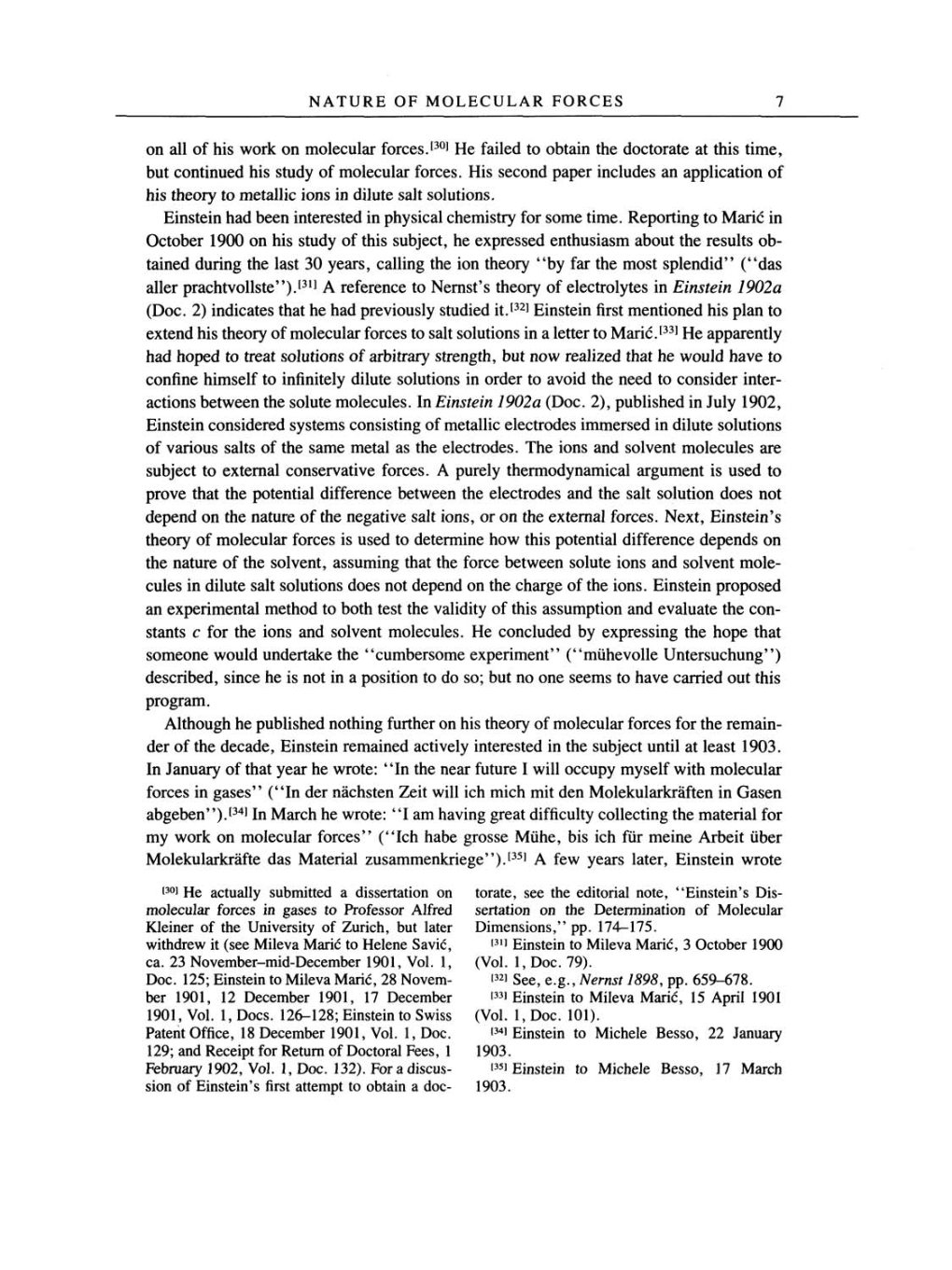NATURE OF MOLECULAR FORCES
7
on
all
of
his work
on
molecular
forces.[30]
He failed to obtain the doctorate at this
time,
but continued
his
study
of
molecular forces.
His second
paper
includes
an
application
of
his
theory
to
metallic ions in dilute salt solutions.
Einstein had been interested in
physical chemistry
for
some
time.
Reporting
to Maric in
October 1900
on
his
study
of
this
subject,
he
expressed
enthusiasm
about
the
results
ob-
tained
during
the
last
30
years,
calling
the ion
theory
"by
far the most
splendid"
("das
aller
prachtvollste").[31]
A reference to
Nernst's
theory
of
electrolytes
in
Einstein 1902a
(Doc. 2)
indicates that he had
previously
studied
it.[32]
Einstein first mentioned his
plan
to
extend his
theory
of
molecular forces to salt solutions in
a
letter to
Maric.[33]
He
apparently
had
hoped
to treat solutions
of
arbitrary strength,
but
now
realized that he would have to
confine
himself
to
infinitely
dilute solutions
in
order
to avoid the need to
consider
inter-
actions between the solute molecules. In Einstein 1902a
(Doc. 2),
published
in
July
1902,
Einstein considered
systems consisting
of
metallic electrodes immersed
in
dilute solutions
of
various salts
of
the
same
metal
as
the electrodes. The
ions
and solvent molecules
are
subject
to external conservative forces.
A
purely
thermodynamical argument
is used to
prove
that
the
potential
difference between the electrodes
and
the salt solution does not
depend on
the nature
of
the
negative
salt
ions,
or
on
the external forces. Next,
Einstein's
theory
of molecular
forces is used
to
determine how this
potential
difference
depends on
the nature
of
the
solvent,
assuming
that the force between solute ions and solvent mole-
cules in dilute salt solutions does not
depend on
the
charge
of
the ions. Einstein
proposed
an experimental
method to both test the
validity
of
this
assumption
and
evaluate
the
con-
stants
c
for
the ions and solvent molecules. He concluded
by expressing
the
hope
that
someone
would undertake the
"cumbersome
experiment"
("mühevolle
Untersuchung")
described, since he
is
not in
a position
to
do
so;
but
no one seems
to have carried out this
program.
Although
he
published nothing
further
on
his
theory
of
molecular forces
for
the remain-
der
of
the
decade,
Einstein remained
actively
interested in the
subject
until at least 1903.
In
January
of
that
year
he wrote:
"In
the
near
future
I
will
occupy
myself
with
molecular
forces in
gases"
("In
der nächsten Zeit will ich mich mit den
Molekularkräften
in Gasen
abgeben").[34]
In
March
he
wrote:
"I
am
having great difficulty
collecting
the material
for
my
work
on
molecular
forces"
("Ich
habe
grosse Mühe,
bis ich für meine
Arbeit
über
Molekularkräfte das Material
zusammenkriege").[35]
A few
years
later,
Einstein
wrote
[30]
He
actually
submitted
a
dissertation
on
molecular
forces in
gases
to
Professor Alfred
Kleiner
of
the
University
of
Zurich,
but later
withdrew it
(see
Mileva Maric
to
Helene
Savic,
ca.
23
November-mid-December
1901,
Vol.
1,
Doc.
125;
Einstein
to
Mileva
Maric,
28 Novem-
ber
1901, 12
December
1901, 17
December
1901,
Vol.
1,
Docs. 126-128; Einstein to Swiss
Patent
Office, 18
December
1901,
Vol.
1,
Doc.
129;
and
Receipt
for
Return
of
Doctoral
Fees,
1
February
1902,
Vol.
1,
Doc.
132).
For
a
discus-
sion
of Einstein's
first
attempt
to obtain
a
doc-
torate,
see
the
editorial
note,
"Einstein's
Dis-
sertation
on
the Determination
of
Molecular
Dimensions,"
pp.
174-175.
[31]
Einstein
to
Mileva
Maric, 3
October
1900
(Vol.
1,
Doc.
79).
[32] See,
e.g.,
Nernst
1898,
pp.
659-678.
[33]
Einstein to Mileva
Maric, 15
April
1901
(Vol. 1,
Doc.
101).
[34]
Einstein
to Michele Besso, 22
January
1903.
[35]
Einstein
to
Michele
Besso,
17 March
1903.
